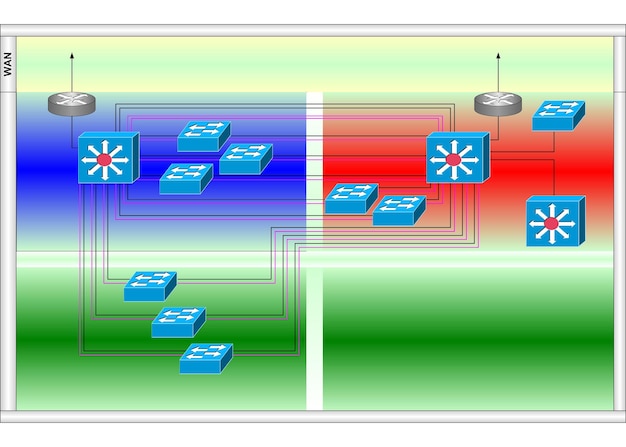Edge Computing: US Businesses Benefit from Faster Data Processing

Edge computing brings data processing closer to the source, offering US businesses faster speeds, reduced latency, and enhanced security, leading to improved efficiency and innovative solutions.
The rise of edge computing: How US businesses can benefit from faster data processing is transforming how data is handled and utilized. By moving computation and data storage closer to the devices where it’s being gathered, companies can unlock significant advancements in speed, efficiency, and security.
Understanding the Basics of Edge Computing
Edge computing represents a paradigm shift from traditional centralized cloud computing models. It involves processing data closer to the source, such as IoT devices, sensors, or local servers, rather than sending it all the way to a distant data center. This approach offers several advantages, particularly for businesses operating in the US.
The core concept revolves around minimizing latency and bandwidth usage. By performing computations and data analysis on-site or near the data source, edge computing reduces the time it takes for information to be processed and acted upon. This is crucial for applications that require real-time responses, such as autonomous vehicles, industrial automation, and augmented reality.
Key Components of an Edge Computing System
An edge computing system comprises various components working together to enable decentralized data processing. Understanding these components is essential for businesses looking to implement edge solutions.
- Edge Devices: These are devices that generate and collect data, such as sensors, cameras, and industrial equipment.
- Edge Servers: Local servers positioned close to the edge devices, providing compute and storage resources for data processing.
- Edge Gateways: These gateways manage communication between edge devices and the central cloud, ensuring secure and reliable data transfer.
Benefits of Decentralized Data Processing
Decentralized data processing offers distinct benefits, allowing for improved performance and more efficient resource utilization. Local processing leads to decreased latency, faster response times, and reduced bandwidth consumption. With quicker access to insights, businesses can enhance operational efficiency, improve customer experiences, and explore innovative applications.

Edge computing empowers businesses to make swift, informed decisions directly at the edge. As data processing occurs virtually in real-time, delays are minimized or eliminated – leading to heightened customer satisfaction and allowing agile adaptation as conditions change. Edge computing helps cut operational costs, enhances data security, and boosts regulatory compliance. Overall, it delivers critical advantages for contemporary enterprises.
How US Businesses Can Leverage Edge Computing
US companies are discovering the practical applications of edge computing, with many sectors experiencing increased innovation and efficiency. Here are some specific use cases illustrating the advantages of edge computing across different industries.
From smart factories optimizing manufacturing processes to healthcare providers monitoring patient conditions, the potential benefits of edge computing are vast. Businesses can reduce latency, improve security, and enable new applications. By exploring these examples, companies can find possibilities that will help them flourish and remain competitive in today’s quickly-changing business world.
Use Cases in Manufacturing
In manufacturing, edge computing can enable real-time monitoring of equipment, predictive maintenance, and automated quality control. Edge devices can collect data from sensors on machines and analyze it locally, identifying potential issues before they cause downtime.
- Real-Time Monitoring: Continuous monitoring of machine performance and environmental conditions.
- Predictive Maintenance: Identifying potential equipment failures before they occur.
- Automated Quality Control: Using AI and machine vision at the edge to ensure product quality.
Use Cases in Healthcare
Healthcare organizations can leverage edge computing to improve patient care, reduce costs, and enhance security. Edge devices can collect data from wearable sensors and medical devices, providing real-time insights into patient health.
- Remote Patient Monitoring: Tracking patient vital signs and health metrics remotely.
- Real-Time Diagnostics: Enabling faster and more accurate diagnoses at the point of care.
- Enhanced Data Security: Protecting sensitive patient data with local processing and encryption.

Edge computing in manufacturing enables process streamlining by enabling real-time equipment tracking, predictive maintenance, and automated quality monitoring. In healthcare, it facilitates remote patient monitoring, quick diagnostics, and higher data safeguards.
Edge Computing and the Internet of Things (IoT)
Edge computing is intrinsically linked to the Internet of Things (IoT). The proliferation of IoT devices has created an explosion of data, making it challenging for traditional cloud computing models to keep up. Edge computing addresses this challenge by processing data closer to the source, reducing the strain on network infrastructure and improving response times.
The relationship between edge computing and IoT is symbiotic. Edge computing enables IoT devices to operate more efficiently and securely, while IoT provides the data that fuels edge applications. This synergy is driving innovation across various industries, from smart homes to smart cities.
The Role of Edge in IoT Data Processing
Edge computing plays a crucial role in processing data generated by IoT devices. By analyzing data locally, edge servers can filter out irrelevant information and send only the important insights to the cloud.
Filtering data close to its source reduces bandwidth demands and decreases latency by removing the need to send all raw data to centralized servers. Additionally, immediate local data processing allows IoT devices to react more promptly – fundamental in fields such as autonomous driving robots and manufacturing equipment that require automated operations in real time. The combination of edge and IoT facilitates smarter and more efficient systems across different applications.
Enhancing Security for IoT Devices
Security is a major concern for IoT deployments. Edge computing enhances security by minimizing the amount of data that needs to be transmitted over the network. Critical data can be stored and processed locally, reducing the risk of interception and unauthorized access.
Edge computing offers better data security for IoT devices by decreasing necessary transmission volumes and empowering local processing and storage of crucial data – lowering risks from eavesdropping or external attacks. Edge technology’s enhanced cybersecurity strengthens the stability and dependability of IoT networks, essential in an era when protection of vulnerable connected devices is critical. It leads to safer and more productive operational ecosystems overall.
Edge computing’s distributed processing approach enhances IoT data processing and tightens device security, facilitating quicker insights, enhanced data management, and a stronger IoT ecosystem.
The Impact of Edge Computing on Data Security and Privacy
Data security and privacy are paramount in today’s digital landscape. Edge computing offers several advantages in this regard, allowing businesses to protect sensitive information and comply with data privacy regulations. By processing data locally, companies can reduce the risk of data breaches and minimize the amount of data that needs to be transmitted over the network.
With the increasing complexity of data privacy regulations, such as GDPR and CCPA, edge computing can help businesses meet their compliance obligations. Data can be processed and stored within specific geographic boundaries, ensuring that it remains subject to local laws and regulations.
Reducing the Risk of Data Breaches
Edge computing minimizes the risk of data breaches by keeping information secure on-site. By processing data at the edge, you reduce the exposure of the data to external threats.
- Local Processing: Data is processed on local servers, reducing the amount of data that needs to be transmitted over the network.
- Data Encryption: Data is encrypted both in transit and at rest, protecting it from unauthorized access.
- Access Controls: Strict access controls are implemented to ensure that only authorized personnel can access sensitive data.
Complying with Data Privacy Regulations
Edge computing assists businesses with compliance around data privacy regulations, by facilitating localized data management that falls within specific regulatory boundaries.
- Data Residency: Data can be stored and processed within specific geographic boundaries, ensuring compliance with local laws.
- Data Minimization: Only necessary data is collected and processed, minimizing the risk of privacy violations.
- Audit Trails: Complete audit trails are maintained to track data access and modifications, facilitating compliance audits.
Edge computing mitigates the danger of data breaches and boosts compliance for data privacy regulations, providing better protection along with better alignment with legal frameworks.
Overcoming the Challenges of Edge Computing Implementation
Implementing edge computing can be complex, with challenges ranging from infrastructure management to security concerns. Addressing these obstacles is crucial for businesses looking to reap the benefits of edge computing.
Scalability, connectivity issues, and the intricacy of managing distributed devices comprise a trio set from which many edge computing snags arise. Despite obstacles often accompanying new deployments, effective planning, strong safety measures, as well as robust administration resources can help businesses utilize their investments and achieve high returns.
Infrastructure Management
Managing a distributed edge infrastructure can be challenging, requiring specialized tools and expertise. Businesses need to ensure that their edge devices and servers are properly configured, monitored, and maintained.
Implementing automated management tools, remote system supervision and standardized configurations helps in overcoming these management impediments. To handle intricate settings and encourage peak implementation, businesses may select managed edge services from reliable vendors.
Connectivity Requirements
Reliable network connectivity is essential for edge computing. Edge devices need to be able to communicate with each other and with the central cloud, even in remote or challenging environments.
Using multiple network options such as cellular, satellite and Wi-Fi reduces the dependency on only one connection system, thereby increasing trustworthiness. Local data caching, message queuing and other strategies also enable edge networks to sustain usefulness even when intermittent connectivity problems occur, ensuring uninterrupted operations.
Tackling issues and embracing the best practices will allow the business to fully utilize its own edge computing abilities.
The Future of Edge Computing in the US Market
The future of edge computing in the US market looks promising, with increasing adoption across various industries. As the number of IoT devices continues to grow, the demand for edge computing solutions will only increase. Businesses that embrace edge computing early will be well-positioned to gain a competitive advantage.
Innovation in edge platforms, AI integration, and expansion of 5G networks stand ready to unleash new potentials across various markets. Early adopters of these advancements will undoubtedly thrive from greater operational agility, boosted efficiencies, and more opportunities for innovation.
Emerging Trends in Edge Computing
Several key trends are shaping the future of edge computing.
- AI at the Edge: The integration of artificial intelligence (AI) and machine learning (ML) at the edge is enabling new applications, like real-time image recognition and predictive analytics.
- 5G Connectivity: The rollout of 5G networks is providing faster and more reliable connectivity for edge devices, enabling new use cases in areas.
- Edge-Cloud Integration: Seamless integration between edge and cloud environments is becoming increasingly important, allowing businesses to leverage the strengths of both.
Predictions for the Next 5 Years
Over the next five years, edge computing is expected to become even more pervasive, with new applications emerging in areas such as autonomous vehicles, smart cities, and industrial automation.
- Increased Adoption: More and more businesses will adopt edge computing solutions to improve efficiency, security, and innovation.
- Advanced Edge Platforms: Edge computing platforms will become more sophisticated, offering enhanced capabilities for data processing, analytics, and management.
- Wider Use Cases: The range of edge computing use cases will continue to expand, driven by the growth of IoT and the increasing demand for real-time data processing.
| Key Point | Brief Description |
|---|---|
| 🚀 Faster Processing | Reduces latency by processing data closer to the source. |
| 🔒 Enhanced Security | Minimizes data breaches by processing data locally. |
| 🌐 IoT Integration | Optimizes data processing for IoT devices. |
| 🏭 Manufacturing | Improving real-time equipment monitoring. |
▼
Edge computing is a distributed computing framework that brings data storage and computation closer to the data source, reducing latency and improving performance.
▼
It helps US businesses by providing faster data processing speeds, reduced latency, enhanced security, and compliance with data privacy regulations.
▼
The main parts include edge devices, edge servers, and edge gateways, each playing a pivotal role in enabling distributed data processing.
▼
Edge computing enhances data security by processing data locally and reducing the amount of data that needs to be transmitted over the network.
▼
Key trends encompass AI integration at the edge, rollout of 5G networks, and enhanced edge-cloud integration for better performance and scalability.
Conclusion
In conclusion, edge computing: How US businesses can benefit from faster data processing offers transformative potential for US businesses. By embracing edge computing, companies can unlock new opportunities for efficiency, security, and innovation, paving the way for success in an increasingly connected world.